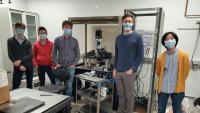February 2022: Christopher Makinson Lab

Background:
What is the main focus of your lab?
My lab studies neurodevelopmental disorders with an emphasis on conditions associated with epilepsy.
How long have you had your lab? When did you join Columbia University?
I moved from Stanford, where I completed my postdoctoral studies, in Oct of 2020.
How big is your lab currently?
We have five lab members currently. 1 ARS, 1 postdoc, 2 graduate students, 1 post-bac
Where is your lab located?
We are in the Hammer Health Sciences Center at CUIMC.
Current affairs:
What are the most exciting projects/directions in the lab at this moment?
Using assemblies of region-specific brain organoids to study neural circuit development: We are investigating how different types of activity and mutations associated with epilepsy influence circuit formation and maturation.
We are also developing novel tools to influence and read out neuronal activity in 3D cellular systems.
What are the biggest accomplishments that your lab recently had?
We have made a lot of progress over the past year setting up electrophysiology and imaging systems including a state of the art two-photon imaging/electrophysiology rig. We have also had success with fellowship proposal applications and grants including a postdoctoral training fewlowship from the Swiss National Science Foundation to Jane Simko, an American Epilepsy Society predoctoral training grant to Wanqi Wang, a foundation grant award to study STXBP1 disorder with our collaborator Michael Boland, and an R21 award (NIH) with our collaborator Wayne Frankel to study epilpepsy caused by mutations in the NMDA receptor gene GRIN2D.
Technology:
What are the model systems that your lab is using?
We are generating human iPS-derived brain organoid models of voltage gated sodium channel-related epilepsies. We have models of SCN8A and are working with Barbara Corneo and the Columbia Stem Cell Core to generate additional SCN8A and SCN3A hiPS models.
What are the key techniques that your lab is using? Are you open to training scientists from other labs?
The key techniques we are using are 3D neuronal cell culture and rodent brain slice approaches, single and multiphoton imaging of flurorescent sensors, and extracellular and intracellular electrophysiology approaches. Of course scientists from other labs who would like to learn these techniques are welcome!
What facilities or equipment does your lab absolutely rely upon? Do you use CSCI cores?
We have worked with the CSCI Stem Cell Core for genome editing of clinically-relelvant epilepsy mutations into human hiPS cells.
Who shall be contacted with questions about equipment, resources and training?
Please reach out to Chrisopher Makinson (cm3966@cumc.columbia.edu) regarding training and access to equipment and resources in the Makinson lab.
Training:
What's your best approach to mentoring trainees in the lab?
My approach to mentoring is to facilitate trainees’ development as a scientist while building an inclusive environment that fosters creativity and encourages respectful questioning and a free exchange of ideas. Moreover, it is important to promote rigor and transparency and establish best practices of research. As science is increasingly team-based, I think that trainees should be part of an integrated team with assistance from techs and/or an Associate Research Scientists, while maintaining opportunities to develop their own mentoring style by working with junior graduate students, undergraduates, and/or high school students.
Can you recommend courses/lectures in Columbia University that would be most beneficial for students/postdocs?
I would recommend the Seminars in Genomics, Genetics & Disease Modeling hosted by CPMG and IGM. For studends interested in translational applications of stem cells, I would recomend the course Stem Cells, Genome Engineering and Regenerative Medicine (BME6510) organized by Stephen Tsang, Gordana Vunjak-Novakovic, and Dieter Egli.
What would be your career advice for students/postdocs?
My advice would be to understand that when you join a lab you are chosing an area of study and a project, but also a sponsor/advocate/mentor who you will rely on for many years even after you move from the lab. Start your project with a plan. I recommend using the Individual Development Plan (IDP) as a starting place, and revisit this at least once each year with your mentor and menoring committee.
Are you accepting rotating students at the moment?
We are accepting rotation students at the moment.
Lab management:
What was the most exciting part about starting your new lab?
The most exciting aspect of starting a lab has been getting to work with the extreemly talented and motivated students here at Columbia and supporting them in the development of their projects.
Stem Cell Directions:
What are the most important recent developments in the stem cell field?
3D brain organoid systems have opened up completely novel avenues for basic and translational neuroscience research.
CSCI:
What was the main reason of you joining CSCI? What are the beneficial aspects of CSCI membership for your lab?
A core tenet of my lab is develop 3D human model systems and advance methods to reliably interrogate the function of these systems, which relies on stem cells. Being connected with CSCI is integral to staying on top of the latest advances and also sharing insights from my lab with the broader community.
What do you plan to bring to the CSCI community?
My lab is investing heavily in tools and methods to assess function in iPS-derived neuronal and rodent brain perparations. These include, novel optical sensors and photoactive compounds as well as established methods such as calcium imaging, multielectrode array, and whole cell electrophyisiology recordings.